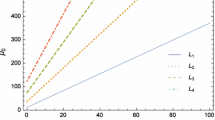Abstract
We present a method, based on the Chebyshev third-order algorithm and accelerated by a Shamanskii-like process, for solving nonlinear systems of equations. We show that this new method has a quintic convergence order. We will also focus on efficiency of high-order methods and more precisely on our new Chebyshev–Shamanskii method. We also identify the optimal use of the same Jacobian in the Shamanskii process applied to the Chebyshev method. Some numerical illustrations will confirm our theoretical analysis.








Similar content being viewed by others
References
Moré, J.J., Garbow, B.S., Hillstrom, K.E.: Testing unconstrained optimization software. ACM Trans. Math. Softw. 7(1), 17–41 (1981)
Rall, L.B., Tapia, R.A.: The Kantorovich theorem and error estimates for Newton’s method. Mathematics Research (1970)
Chebyshev, P.L.: Collected works. Number 5. Moscow–Leningrad (1951)
Halley, E.: A new, exact and easy method of finding roots of any equations generally, and that without any previous reduction. Philos. Trans. Roy. Soc. (1964)
Gutiérrez, J.M., Hernández, M.A.: An acceleration of Newton’s method: Super-Halley method. Appl. Math. Comput. 117(2–3), 223–239 (2001)
Ezquerro, J.A.: A modification of the Chebyshev method. IMA J. Numer. Anal. 17, 511–525 (1997)
Ezquerro, J.A., Hernández, M.A.: An improvement of the region of accessibility of Chebyshev’s method from newton’s method. Math. Comput. 78(264), 1613–1627 (2009)
Ezquerro, J.A., Hernández, M.A., Romero, N.: On some one-point hybrid iterative methods. Nonlinear Anal. 72, 587–601 (2010)
Griewank, A.: Evaluating Derivatives, Principles and Techniques of Algorithmic Differentiation. SIAM, Philadelphia (2008)
Zhang, H.: On the Halley class of methods for unconstrained optimization problems. Optim. Methods Softw. 25(5), 753–762 (2009)
Shamanskii, V.: On a modification of the Newton method. Mat. Zametki 19, 133–138 (1967)
Ortega, J.T., Rheinboldt, W.C.: Iterative Solution of Nonlinear Equations in Several Variables. Academic Press, New York (1970)
Traub, J.F.: Iterative Methods for the Solution of Equations. Prentice-Hall, Englewood Cliffs (1964)
Kelley, C.T.: Iterative Methods for Optimization. SIAM, Philadelphia (1995)
Lampariello, F., Sciandrone, M.: Global convergence technique for the Newton method with periodic Hessian evaluation. J. Optim. Theory Appl. 111(2), 341–358 (2001)
Brent, R.P.: Some efficient algorithms for solving systems of nonlinear equations. J. Nucleic Acids 10(2), 327–344 (1973)
Ostrowski, A.M.: Solutions of Equations in Euclidean and Banach Spaces. Academic Press, New York (1973)
Ezquerro, J., Grau-Sánchez, M., Grau, A., Hernández, M., Noguera, M., Romero, N.: On iterative methods with accelerated convergence for solving systems of nonlinear equations. J. Optim. Theory Appl. 151(1), 163–174 (2011)
Gundersen, G., Steihaug, T.: On large scale unconstrained optimization problems and higher-order methods. Optim. Methods Softw. 25(3), 337–358 (2010)
Kchouk, B., Dussault, J.-P.: A new family of high order directions for unconstrained optimization inspired by Chebyshev and Shamanskii methods. Technical report, University of Sherbrooke, Optimization-online.org (2011)
Fox, L.: An Introduction to Numerical Linear Algebra. Clarendon Press, Oxford (1964)
Dussault, J.-P.: High-order Newton-penalty algorithms. J. Comput. Appl. Math. 182(1), 117–133 (2005)
Baur, W., Strassen, V.: The complexity of partial derivatives. Theor. Comput. Sci. 22, 300–317 (1983)
Griewank, A.: On automatic differentiation. Math. Program., Recent. Dev. Appl. 6, 83–108 (1989)
Dussault, J.-P., Hamelin, B., Kchouk, B.: Implementation issues for high-order algorithms. Acta Math. Vietnam. 34(1), 91–103 (2009)
Acknowledgements
This research was partially supported by NSERC grant OGP0005491, by the Institut des sciences mathématiques (ISM), and the Department of Mathematics of the University of Sherbrooke
Author information
Authors and Affiliations
Corresponding author
Additional information
Communicated by Jean-Pierre Crouzeix.
Appendices
Appendix A: Test Functions
We tested our algorithms on the following functions, from the Moré, Garbow and Hillstrom collection [1]:
where f 1,…,f m are defined by the following problems. We adopt the following general format described in [1] and add the expression of \(F_{i}= \frac{\partial f(x)}{\partial x_{i}}\).
Name of function
-
(a)
Dimensions
-
(b)
Function definition
-
(c)
Standard starting point
-
(d)
Minima
-
(e)
Expression of the Gradient \(F_{i}= \frac{\partial f(x)}{\partial x_{i}}\).
Thus, our four test functions are:
Problem 1
Broyden tridiagonal function
-
(a)
n variable, m=n
-
(b)
f i (x)=(3−2x i )x i −x i−1−2x i+1+1 where x 0=x n+1=0
-
(c)
x 0=(−1,…,−1)
-
(d)
f=0
-
(e)
F i =−4f i−1(x)+2(3−12x i )f i (x)−2f i+1(x).
Problem 2
Broyden banded function
-
(a)
n variable, m=n
-
(b)
\(f_{i}(x)=x_{i}(2+5x_{i}^{2})+1-\sum_{j \in J_{i}} x_{j}(1+x_{i}) \) where J i ={j:j≠i,max(1,i−m l )≤j≤min(n,i+m u )} and m l =5, m u =1
-
(c)
x 0=(−1,…,−1)
-
(d)
f=0
-
(e)
\(F_{i}=2(1+15x_{i}^{2}-2x_{i})f_{i}(x)\).
Problem 3
Discrete boundary value function
-
(a)
n variable, m=n
-
(b)
f i (x)=2x i −x i−1−x i+1+h 2(x i +t i +1)3/2 where h=1/n+1=0, t i =ih and x 0=x n+1=0
-
(c)
x 0=(ζ j ) where ζ j =t j (t j −1)
-
(d)
f=0
-
(e)
\(F_{i}=-2f_{i-1}(x)+2[2+\frac {3}{2}h^{2}(x_{i}+t_{i}+1)^{2}]f_{i}(x)-2f_{i+1}(x)\).
Problem 4
Discrete integral equation function
-
(a)
n variable, m=n
-
(b)
\(f_{i}(x)=x_{i}+h[(1-t_{i})\sum_{j=1}^{i} t_{j}(x_{j}+t_{j}+1)^{3}+t_{i}\sum_{j=i+1}^{n} (1-t_{j})(x_{j}+ t_{j}+1)^{3}]/2\) where h=1/(n+1), t i =ih and x 0=x n+1=0
-
(c)
x 0=(ζ j ) where ζ j =t j (t j −1)
-
(d)
f=0
-
(e)
\(F_{i}=2[1+\frac {3}{2}ht_{i}(x_{i}+t_{i}+1)^{2}]f_{i}(x)\).
Table 4 gives details about the costs of the tested problems.
Appendix B: Unsymmetric Systems
If one considers unsymmetric systems, the detailed analysis for the costs involved in high-order methods is given in Table 5.
Thus, the costs of the Newton and Chebyshev methods are:

Consequently, the efficiency of the Newton method is

and the efficiency of the Chebyshev method is

As in Sect. 5, we obtain the same ratio between efficiencies of the Chebyshev–Shamanskii method and the Chebyshev method, as the additional cost of the Chebyshev–Shamanskii method given in Corollary 3.1 is still valid, i.e.

Thus, if c is approximated by n 2, E(CS)/E(d C )>1 for n>22; in other words, the Chebyshev–Shamanskii method is more efficient than the pure Chebyshev’s for n>22. If c is approximated by n 3, then the same result is valid for n>29.
Rights and permissions
About this article
Cite this article
Kchouk, B., Dussault, JP. The Chebyshev–Shamanskii Method for Solving Systems of Nonlinear Equations. J Optim Theory Appl 157, 148–167 (2013). https://doi.org/10.1007/s10957-012-0159-6
Received:
Accepted:
Published:
Issue Date:
DOI: https://doi.org/10.1007/s10957-012-0159-6



